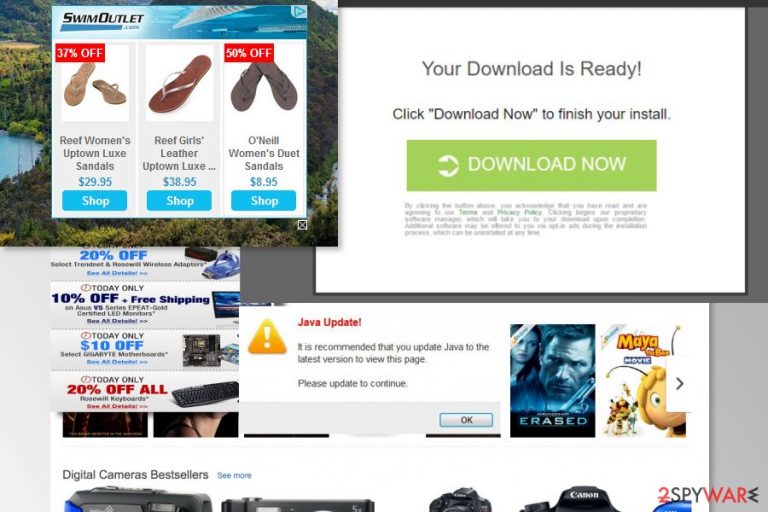WebOptimum Ads (Removal Guide) - Oct 2017 update
WebOptimum ads Removal Guide
What is WebOptimum Ads?
Web Optimum might bombard your web browser with annoying ads

WebOptimum is an adware[1] program that is responsible for delivering tons of advertisements on the affected web browser and redirecting users to the promotional websites. This potentially unwanted program (PUP) usually sneaks inside the system bundled with various free applications.
The WebOptimum virus has been noticed spreading in the form of the browser extension. This add-on is not available in the official app stores, such as Chrome Web Store. However, it might arrive on the system in the software bundle. One of the first signs of the browser hijack is changed homepage to EZ Search.
If adware sneaks inside the system you can find one of these processes running too:
- WebOptimum.exe,
- WebOptimum-bg.exe,
- WebOptimum-bho64.dll,
- WebOptimum-nova.exe.
If you see one of these processes running on your PC, you should scan the system with FortectIntego or another anti-malware to remove WebOptimum from the device until it hasn’t flooded your browser’s with ads. This adware might cause havoc when you browse the web using Chrome, Firefox, Internet Explorer, Safari, and other web browsers.
The Web Optimum adware might compromise DNS settings[2] and enables its extension by force. Right after that, seeking to generate advertising revenue boost traffic to affiliate websites, it starts generating targeting advertisements. “Web Optimum Ads” are indeed intrusive. They show up on random websites and in very irritating forms (pop-up ads, banner ads, in-text links, interstitials, video ads, new tab ads, etc.) and can be excluded into two main categories:
- Sponsored advertisements. Web Optimum redirects typically make people visit affiliate websites that need to increase page rank or boost sales. Such advertisements are annoying because due to their intrusiveness you may click on them accidentally and be redirected to unwanted websites quite frequently. Security experts from Les Virus[3] note, that ad-supported program might redirect to potentially dangerous websites too.
- Fake advertisements. In some of the occasions, Web Optimum virus may generate third-party ads that may be used for spreading malware/PUP or even virus.[4] Such pop-ups may or may not be marked as “Ads by WebOptimum.” Anyway, such ads typically urge people to upgrade Java, Media Player, Flash Player, VLC Player, web browser, download manager, and so on. Thus, clicking on “Download” or “Update now” buttons can lead to other computer-related issues.
Potentially dangerous WebOptimum redirect tendencies are not the only problem related to this cyber threat. This PUP might also use tracking cookies to collect various information about users, including search queries, pages viewed, data that attract people's attention, and collection of PC's IP address, approximate geolocation, email address, and similar non-personal information.
However, no one can assure that adware cannot collect and share with third-parties personal details as well. Thus, in order to avoid privacy-related issues,[5] you should focus on WebOptimum removal as soon as you found suspicious ads on your browser.

Adware distribution methods
We have already mentioned that the WebOptimum hijack might occur when users download various free programs from the Internet. The adware might sneak inside when users choose Quick/Standard installation settings which do not openly disclose about third-party software.
In order to avoid unintentional installation of PUPs, you should always opt for Advanced/Custom settings and carefully follow each of the steps. If you encounter the list of “optional downloads,” remove ticks from pre-selected entries and stop their installation.
Getting rid of the WebOptimum ads
The annoying ads are delivered by adware program. Thus, to get rid of them, you have to remove WebOptimum from the computer. You can follow the instructions below and delete virus-related programs and files from the system.
For complete WebOptimum removal, you should also reset each of the web browsers installed on your PC. This helps to delete tracking cookies and get rid of other invisible adware-related components.
You may remove virus damage with a help of FortectIntego. SpyHunter 5Combo Cleaner and Malwarebytes are recommended to detect potentially unwanted programs and viruses with all their files and registry entries that are related to them.
Getting rid of WebOptimum ads. Follow these steps
Uninstall from Windows
You can find manual WebOptimum removal guide from Windows OS below:
Instructions for Windows 10/8 machines:
- Enter Control Panel into Windows search box and hit Enter or click on the search result.
- Under Programs, select Uninstall a program.

- From the list, find the entry of the suspicious program.
- Right-click on the application and select Uninstall.
- If User Account Control shows up, click Yes.
- Wait till uninstallation process is complete and click OK.

If you are Windows 7/XP user, proceed with the following instructions:
- Click on Windows Start > Control Panel located on the right pane (if you are Windows XP user, click on Add/Remove Programs).
- In Control Panel, select Programs > Uninstall a program.

- Pick the unwanted application by clicking on it once.
- At the top, click Uninstall/Change.
- In the confirmation prompt, pick Yes.
- Click OK once the removal process is finished.
Delete from macOS
If your Mac is bombarded with annoying WebOptimum ads, you should look up for the adware related components:
Remove items from Applications folder:
- From the menu bar, select Go > Applications.
- In the Applications folder, look for all related entries.
- Click on the app and drag it to Trash (or right-click and pick Move to Trash)

To fully remove an unwanted app, you need to access Application Support, LaunchAgents, and LaunchDaemons folders and delete relevant files:
- Select Go > Go to Folder.
- Enter /Library/Application Support and click Go or press Enter.
- In the Application Support folder, look for any dubious entries and then delete them.
- Now enter /Library/LaunchAgents and /Library/LaunchDaemons folders the same way and terminate all the related .plist files.

Remove from Microsoft Edge
Microsoft Edge reset is suggested after the hijack:
Delete unwanted extensions from MS Edge:
- Select Menu (three horizontal dots at the top-right of the browser window) and pick Extensions.
- From the list, pick the extension and click on the Gear icon.
- Click on Uninstall at the bottom.

Clear cookies and other browser data:
- Click on the Menu (three horizontal dots at the top-right of the browser window) and select Privacy & security.
- Under Clear browsing data, pick Choose what to clear.
- Select everything (apart from passwords, although you might want to include Media licenses as well, if applicable) and click on Clear.

Restore new tab and homepage settings:
- Click the menu icon and choose Settings.
- Then find On startup section.
- Click Disable if you found any suspicious domain.
Reset MS Edge if the above steps did not work:
- Press on Ctrl + Shift + Esc to open Task Manager.
- Click on More details arrow at the bottom of the window.
- Select Details tab.
- Now scroll down and locate every entry with Microsoft Edge name in it. Right-click on each of them and select End Task to stop MS Edge from running.

If this solution failed to help you, you need to use an advanced Edge reset method. Note that you need to backup your data before proceeding.
- Find the following folder on your computer: C:\\Users\\%username%\\AppData\\Local\\Packages\\Microsoft.MicrosoftEdge_8wekyb3d8bbwe.
- Press Ctrl + A on your keyboard to select all folders.
- Right-click on them and pick Delete

- Now right-click on the Start button and pick Windows PowerShell (Admin).
- When the new window opens, copy and paste the following command, and then press Enter:
Get-AppXPackage -AllUsers -Name Microsoft.MicrosoftEdge | Foreach {Add-AppxPackage -DisableDevelopmentMode -Register “$($_.InstallLocation)\\AppXManifest.xml” -Verbose

Instructions for Chromium-based Edge
Delete extensions from MS Edge (Chromium):
- Open Edge and click select Settings > Extensions.
- Delete unwanted extensions by clicking Remove.

Clear cache and site data:
- Click on Menu and go to Settings.
- Select Privacy, search and services.
- Under Clear browsing data, pick Choose what to clear.
- Under Time range, pick All time.
- Select Clear now.

Reset Chromium-based MS Edge:
- Click on Menu and select Settings.
- On the left side, pick Reset settings.
- Select Restore settings to their default values.
- Confirm with Reset.

Remove from Mozilla Firefox (FF)
In order to stop bothersome WebOptimum ads and redirects, follow these steps:
Remove dangerous extensions:
- Open Mozilla Firefox browser and click on the Menu (three horizontal lines at the top-right of the window).
- Select Add-ons.
- In here, select unwanted plugin and click Remove.

Reset the homepage:
- Click three horizontal lines at the top right corner to open the menu.
- Choose Options.
- Under Home options, enter your preferred site that will open every time you newly open the Mozilla Firefox.
Clear cookies and site data:
- Click Menu and pick Settings.
- Go to Privacy & Security section.
- Scroll down to locate Cookies and Site Data.
- Click on Clear Data…
- Select Cookies and Site Data, as well as Cached Web Content and press Clear.

Reset Mozilla Firefox
If clearing the browser as explained above did not help, reset Mozilla Firefox:
- Open Mozilla Firefox browser and click the Menu.
- Go to Help and then choose Troubleshooting Information.

- Under Give Firefox a tune up section, click on Refresh Firefox…
- Once the pop-up shows up, confirm the action by pressing on Refresh Firefox.

Remove from Google Chrome
Remove adware-related components from Google Chrome and reset the browser:
Delete malicious extensions from Google Chrome:
- Open Google Chrome, click on the Menu (three vertical dots at the top-right corner) and select More tools > Extensions.
- In the newly opened window, you will see all the installed extensions. Uninstall all the suspicious plugins that might be related to the unwanted program by clicking Remove.

Clear cache and web data from Chrome:
- Click on Menu and pick Settings.
- Under Privacy and security, select Clear browsing data.
- Select Browsing history, Cookies and other site data, as well as Cached images and files.
- Click Clear data.

Change your homepage:
- Click menu and choose Settings.
- Look for a suspicious site in the On startup section.
- Click on Open a specific or set of pages and click on three dots to find the Remove option.
Reset Google Chrome:
If the previous methods did not help you, reset Google Chrome to eliminate all the unwanted components:
- Click on Menu and select Settings.
- In the Settings, scroll down and click Advanced.
- Scroll down and locate Reset and clean up section.
- Now click Restore settings to their original defaults.
- Confirm with Reset settings.

Delete from Safari
These guidelines will help you to clean Safari from the potentially dangerous components:
Remove unwanted extensions from Safari:
- Click Safari > Preferences…
- In the new window, pick Extensions.
- Select the unwanted extension and select Uninstall.

Clear cookies and other website data from Safari:
- Click Safari > Clear History…
- From the drop-down menu under Clear, pick all history.
- Confirm with Clear History.

Reset Safari if the above-mentioned steps did not help you:
- Click Safari > Preferences…
- Go to Advanced tab.
- Tick the Show Develop menu in menu bar.
- From the menu bar, click Develop, and then select Empty Caches.

After uninstalling this potentially unwanted program (PUP) and fixing each of your web browsers, we recommend you to scan your PC system with a reputable anti-spyware. This will help you to get rid of WebOptimum registry traces and will also identify related parasites or possible malware infections on your computer. For that you can use our top-rated malware remover: FortectIntego, SpyHunter 5Combo Cleaner or Malwarebytes.
How to prevent from getting adware
Stream videos without limitations, no matter where you are
There are multiple parties that could find out almost anything about you by checking your online activity. While this is highly unlikely, advertisers and tech companies are constantly tracking you online. The first step to privacy should be a secure browser that focuses on tracker reduction to a minimum.
Even if you employ a secure browser, you will not be able to access websites that are restricted due to local government laws or other reasons. In other words, you may not be able to stream Disney+ or US-based Netflix in some countries. To bypass these restrictions, you can employ a powerful Private Internet Access VPN, which provides dedicated servers for torrenting and streaming, not slowing you down in the process.
Data backups are important – recover your lost files
Ransomware is one of the biggest threats to personal data. Once it is executed on a machine, it launches a sophisticated encryption algorithm that locks all your files, although it does not destroy them. The most common misconception is that anti-malware software can return files to their previous states. This is not true, however, and data remains locked after the malicious payload is deleted.
While regular data backups are the only secure method to recover your files after a ransomware attack, tools such as Data Recovery Pro can also be effective and restore at least some of your lost data.
- ^ Adware. Wikipedia. The free encyclopedia.
- ^ Codrut Neagu. Simple questions: What is DNS? How do I see my DNS settings in Windows?. Digital Citizen. Tutorials, reviews, news and other articles about productivity, entertainment, security, smarthome, smartphone and health.
- ^ Les Virus. Les Virus. French cyber security news.
- ^ Lenny Zeltser. Malvertising: The Use of Malicious Ads to Install Malware. Infosec Island. Online Community for Information Security Enthusiasts.
- ^ Craig Charles. 5 cyber-security and privacy issues you’ll hear about in 2017. ThatsNonsense. Entertainment and news website.
